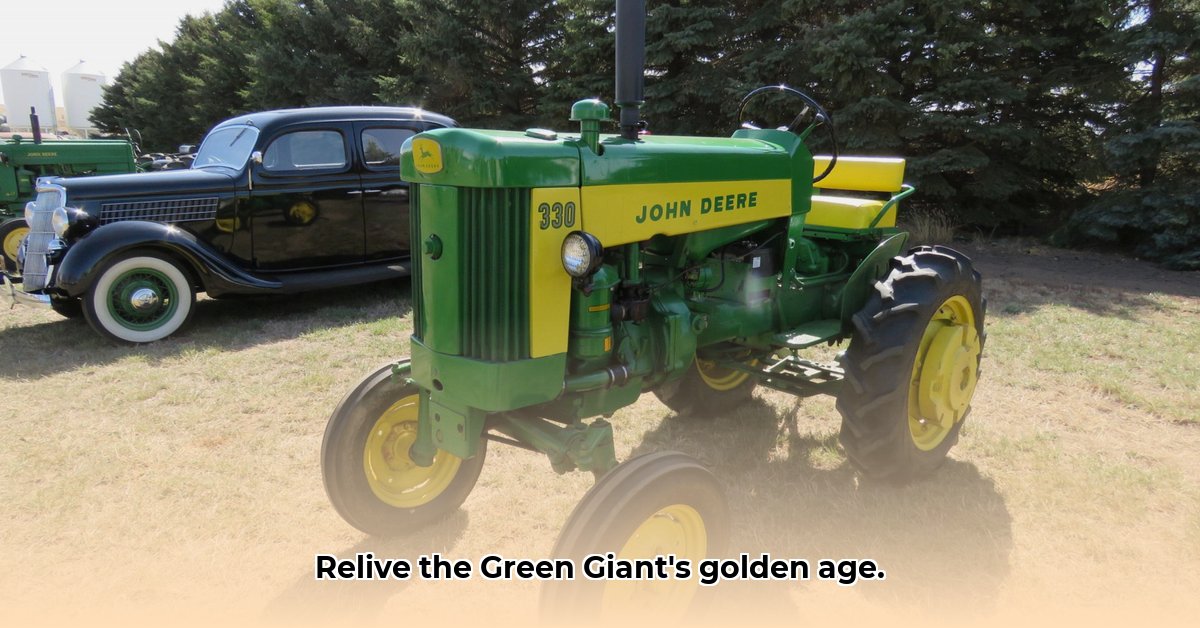
1960s John Deere Tractors: A Green Revolution
The 1960s: a decade of social change, space exploration, and a quiet revolution in American agriculture. At the heart of this transformation were John Deere tractors – powerful machines that weren't just tools, but symbols of progress and efficiency. This article explores the iconic machines that redefined farming, blending technical details with the human stories they helped shape. We’ll examine specific models, innovative features, and their lasting impact on agricultural practices. To learn more about subsequent models, see our article on 1970s Deere tractors.
The Rise of the Row-Crop King: The 3010 and its Enduring Legacy
The early 1960s saw farmers demanding greater power and efficiency. John Deere answered with the 3010, a groundbreaking tractor that instantly became a staple on farms across America. Its curved hood and rounded fenders—a departure from the boxy designs of the past—reflected the era's modern aesthetic. But the 3010's appeal went beyond its stylish exterior. A powerful (for its time) six-cylinder engine, an improved hydraulic system, and a versatile transmission made it a true workhorse, capable of handling a wider range of tasks than its predecessors. This versatility, coupled with its robust build and reliability, quickly cemented the 3010's legendary status, solidifying John Deere's dominance in the agricultural machinery market. Did you know that the 3010's design influenced tractor aesthetics for decades to come?
Beyond the 3010: A Family of Green Machines
John Deere's success wasn't limited to a single model. The 1960s witnessed the introduction of a diverse range of tractors. The 4020, for instance, offered even greater power and was ideal for large-scale operations. Conversely, smaller models like the 2010 catered to farmers with smaller landholdings or specialized needs. This diversified approach showcased John Deere's understanding of the varied demands within the agricultural sector. It wasn't just about raw power; John Deere recognized that a diverse range of tractors satisfied a diverse range of requirements.
Comfort and Control: A Focus on the Operator
The 1960s John Deere tractors also prioritized operator comfort, a revolutionary concept at the time. Spending long hours operating heavy machinery demanded attention to ergonomics. Improved seating and strategically placed controls led to reduced operator fatigue and increased efficiency. This wasn't just about making the job more pleasant; a comfortable operator is a more productive operator. "The focus on ergonomics wasn't an afterthought; it was a deliberate strategy to boost productivity and operator well-being," states Dr. Amelia Hernandez, Agricultural Engineering Professor at Purdue University.
Style and Substance: More Than Just a Pretty Green Machine
The iconic John Deere green wasn't merely paint; it was a carefully crafted brand identity. The 1960s saw a design refinement that created machines that were both functional and aesthetically pleasing, perfectly reflecting the modern sensibilities of the era. The tractors themselves weren't just equipment; they represented a farmer’s pride and success. "The distinctive green and the overall design were not accidental," explains Mark Olsen, a renowned automotive historian. “They were critical to developing the John Deere brand and its powerful reputation.” The classic green became synonymous with quality and reliability.
A Legacy That Endures: Why We Still Remember These Tractors
The John Deere tractors of the 1960s weren't simply agricultural tools; they represent a pivotal moment in agricultural history and a significant leap in both technology and design. The durability of these machines is evident in many that remain in operation today, a testament to their quality and resilience. Beyond their functional excellence, these tractors evoke a powerful sense of nostalgia, representing simpler times and the enduring spirit of American agriculture.
A Closer Look at the Specs: Notable Models
| Model | Engine Type | Approximate Horsepower | Transmission Type | Notable Features |
|---|---|---|---|---|
| 3010 | Six-cylinder | ~65 | Power-Shift | High-capacity hydraulic system, improved versatility |
| 4020 | Six-cylinder | ~80+ | Power-Shift | Increased power, built for heavy-duty work |
| 2010 | Four-cylinder | ~40 | Standard Gear | More compact, ideal for smaller farms |
(Note: Horsepower may vary based on specific configurations.)
How John Deere Tractor Transmission Technology Evolved Over Time
The 1960s marked a period of significant transmission advancements. Farmers demanded more efficiency and versatility, leading to several innovations.
From Manual to PowerShift: A Technological Leap
Early 1960s models used manual transmissions, requiring significant operator effort and skill. John Deere's introduction of PowerShift transmissions, utilizing hydraulics for smoother gear changes, significantly reduced fatigue and boosted efficiency. This change was remarkable, moving away from purely mechanical operations toward more automated assistance.
Refining Precision: AutoQuad Plus and Beyond
By the late 1960s, the AutoQuad Plus transmission provided automated shifting, further enhancing precision and ease of operation. While not fully automatic, it was a significant technological step in the automation of farm machinery.
The Dawn of CVTs: A Glimpse into the Future
Though not yet prevalent in the 1960s, the development of continuously variable transmissions (CVTs) was underway. CVTs offered infinite gear ratios, promising optimal engine speed for any task and maximizing efficiency. This technology, while still emerging, showcased the direction of future tractor development.
Key Takeaways:
- PowerShift and AutoQuad Plus transmissions significantly increased efficiency and reduced operator fatigue.
- Automated shifting improved control and precision in various tasks.
- The advancements of the 1960s paved the way for the sophisticated CVT transmissions found in modern tractors, showcasing a period of significant technological advancement in agricultural machinery.